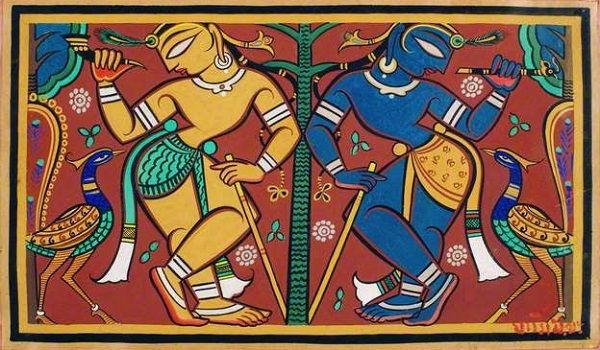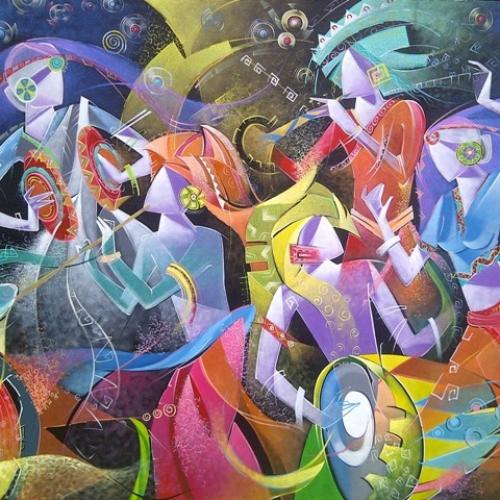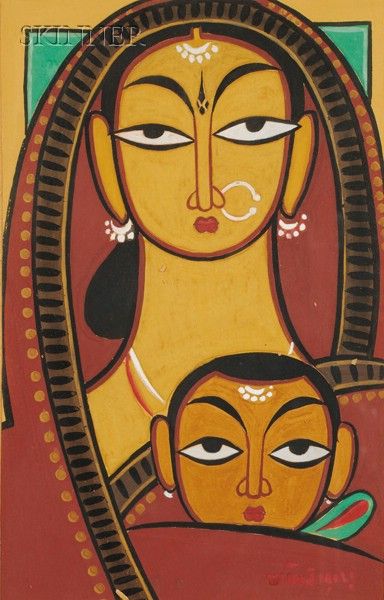In painting, sculpture as well as in music, dance, drama, and pottery a vast store of folk experiences and expression exist, which is alive, and of which our artists have lately become more aware.
Indeed since independence, there has been an exciting revival of the creative spirit throughout rural India. A number of Indian artists have turned to the rich and widespread traditions of folk art for inspiration.
Some adapting to new paint colors, materials, and contemporary themes. A number of Indian artists have turned to the rich and widespread traditions of folk art for inspiration.
This paper is an attempt to analyze the role of folk tradition in Indian contemporary art through various structures of consciousness, to demonstrate further development and influence these traditions to reflect on modern Indian art scenarios.
Suggested: Most Famous Indian Folk Singers of All Time
The subject of Indian folk paintings is as diverse as the Indian cultural milieu itself. Indian folk art painting contains brilliant wall painting, oil, canvas and cloth paintings, cave paintings, miniatures, and so on.
Indian folk art paintings usually deal with vivid depictions of popular Hindu mythological themes and deities.
However, some other subjects like daily village life and natural elements such as plants, flowers, moon, sun, birds, and animals are also depicted beautifully.
Folk paintings are very enticing and a visual treat for the viewer, as they employ vibrant and natural colours, papers, clothes, leaves, earthen pots, mud walls, and so on, as their canvas to paint on.
Folk artists traditionally learn skills and techniques through apprenticeships in informal community settings, though they may also be formally educated.
Any change that is inevitable, due to interior growth or external influences, and which does not cause unnecessary or avoidable disruption of the existing traditional values, is positive.
We must remember that India is the custodian of valuable traditions, social, moral, and artistic.
A number of Indian artists have turned to the rich and widespread traditions of folk art for motivations.
Besides the large variety of folk miniature and manuscript illustrations, including astrological manuscripts and tantric text, Indian folk includes Pata paintings, kali ghat paintings, mural decorations and reliefs on mud walls such as Sanjhi, Mithila from Bihar, Warli from Maharashtra, Kalamkari from Hyderabad Pichawais and Phads from Rajasthan, Kanthasembroidery from West Bengal and a wide range of painted clay and wooden figurines and toys from decorations on ceremonial occasions all over the country.
In fact, it became fashionable to adopt folk idioms in artworks and incorporate folk, tribal and cult motifs into their own contemporary styles.
Such an approach was not limited to visual art alone. Indeed even music and performing art showed a marked influence of folk forms.
Objectives
To explore the significant role played by folk art in the development of Indian contemporary art.
To study the impact of Indian folk art on the present art scenario in India.
Brief history
Their charm was undeniably there and that marked the beginning of the emergence of Indian folk art at a global level.
 |
| folk art_Jamini Roy |
Initially, the study of folk painting was started to emerge in Bengal. Gradually, more and more Indian states realized the value of their own art and derived to create their collections.
Each region used the materials readily available to them and this resulted in tremendous diversity and variety while also being clubbed as one, “Indian” folk art.
Gujarat and southern Rajasthan were well-known for their miniatures. Western India mostly used angular lines, bright and bold colors, and full profiles.
Paintings from the Rajput and Central Indian centers used more individualistic styles, the composition is simple, though more direct.
One of the most significant modernists, Jamini Roy in the 1930s, anticipated the current vogue among artists to adopt folk art and folk mannerisms to furbish their artworks.
One can see both a genuine love for the simple life revealed in the works of Nandlal Bose, BinodBhariMukharji, Asit Kumar Haldar, Masoji, Mukul, and Manishi Dey.
Even in the 1960s, and 1970s, there was an orientation towards textures and abstractions.
Their allegorical paintings, marked by fine use of thick lines, created fantasies based on a folk idiom, relating to the themes of mythology and folklore.
However, the work of K.C.S. Paniker was basically based on abstraction there is an incorporation script, symbols, and geometry on color divisions that functioned as the matrix or background.
A free adaptation of symbols, signs, and motifs from folk and tribal sources is evident in the works of later artists.
During the 1980s folk arts came to exercise with a great fascination for Indian artist who was eager to forge their own identity or ‘Indianness’ through their creative efforts.
Folk art has also played a significant role in innovating the use of mixed media which simultaneously simulates the effect of cloisonné enamel and ‘kolam’ design to create a decorative painting. Their works are contemporary with an Indian flavor.
Role of folk tradition in Indian contemporary art:
Folk artworks, styles, and motifs have inspired various artists. Contemporary folk artists are frequently self-taught as their work is often developed in isolation or in small communities across the country.
Violence against women, female infanticide, and communalism are among the new themes that Indian folk artists are exploring, as they create new contexts for their art and woo urban Indian audiences.
Some consider it a new genre altogether – contemporary Indian folk art. “Folk and tribal art have moved beyond mass-producing the same mythological themes and this has led to galleries identifying them as contemporary artists,” says art and cultural historian Jyotindra Jain.
However, Madhubani artist PushpaKumari interprets that, “You can map this change back through the past decade.
When such forms began to be recognized worldwide, artists began to get a different kind of exposure and some started rethinking their oeuvre altogether.”
This certainly holds true for KalamPatua, the creator of the NirbhayaKand whose work has been showcased at London’s Victoria and Albert Museum.
He said that he was in Delhi in December 2012 and remembers following the Nirbhaya rape case in the news.
It weighed on his conscience, as it did with so many others, and he felt that he had to express the horror of the tragedy through his art. Despite its contemporary themes, Kalam’s work carries the essential characteristic of his art form satire.
He added his own spin, and his range of subjects is unique. Gond artist Venkat Raman Singh Shyam, meanwhile, was inspired by the terror siege of 26/11.
The resultant work, Smoking Taj, captures the iconic image of the burning dome of the hotel, in Shyam’s intricate style.
Among others making the shift from painting Hindu epics, deities and pastoral scenes to sketching contemporary issues are Patachitra artist Anwar Chitrakar, Madhubani artist PushpaKumari and Warli artist Anil Vangad.
Patachitra artist Anwar Chitrakar’s depiction of Saradha chit fund scam. They have etched political and social issues such as the Saradha scam, communal rioting, surrogacy, and changing cityscapes.
Artists are also deciding that they do not want to all be clubbed together, and instead want to be recognized for their own voice.
 |
| Indian Modern & Contemporary Art |
According to Pushpa Kumari, “The traditional themes have become old and monotonous. So much has happened lately that needs to be on canvas”.
Her work features female foeticide and domestic violence for the same reasons.
Based in the coastal town of Dahanu, on the rapidly developing fringes of Mumbai, Warli artist Vangad says he was uniquely situated to examine the altering and expanding cityscape from afar, and that prompted him to move away from established norms for his art.
Vangad also paints the plight of local Adivasi tribals and welcomes being commissioned to paint his views on T-shirts, dupattas, and sarees.
Artists were drawn to folk art, not from a desire to identify with the ethos of the people who created it, but from the growing awareness of the beauty and characteristics vitality of the basic design elements in the innumerable variety of folk forms.
The pictorial devices in India’s indigenous arts bear a similarity to some of the devices used in the archaic culture of the world and which have also been used by artists of the modern art movement in Europe.
The Indian folk artists have used these ingeniously to achieve a complete plastic unity.
These ancient folk art traditions have found their way into modern homes, where they add pops of color, whimsy, and an ethnic aesthetic.
A sixth-generation shawl maker, he says he feels the need to express himself and create his own style.
In Rajasthan, meanwhile, work in the Jogi folk art style shows a husband drinking and shouting at his wife; another shows sadhus doing yoga as monkeys imitate them. Similarly, Gond artist Bhajju Shyam, whose London Jungle Book featured Big Ben as a rooster and the London Underground as an earthworm, is also open to designing wedding cards.
“Not everyone wants a work where a woman is being abused in their homes.
It’s more like catharsis, a way for artists to explore the issues that concern them.” Clearly, contemporary Indian folk art is, at long last, being recognized and valued for its originality, combination of the naive and the sophisticated, and its sheer vitality.
Conclusion
We must remember that folk arts both had a practical and spiritual purpose and were not merely a leisure-time activity.
We must also remember that the development of folk arts had been determined by social and geographical environments.
The images, motifs, and symbols of folk art are the manifestations of values cherished by the people at a particular period of their history.
They are the feature of the past and have continued up to this day, they are not meant to serve merely as creative motivation, but are to be considered as the hallmark of a certain culture- its way of life, its beliefs, its rituals.
These forms of art were the energies that constituted the outward and inward universe of a particular person.
With unlimited inclusivity, mediums, accessibility, and motivation, folk art is integral art.
1. Dadaism 2. Fauvism 3. Synthetic Cubism 4. What is Art 5. Minimalism 6. Philosophy of Art 7. Banksy’s painting 8. Graffiti 9. Facts about Paul Gauguin 10. Beginning of civilization 11.Famous Quotes by Pablo Picasso 12. Leonardo da Vinci quotes 13.George Keyt 14. Gulam Mohammad Sheikh 15. female influential Artist 16. Why did Van Gogh cut off his ear 17. The Starry Night 1889 18. most expensive paintings 19. The Stone Breakers 20. Vocabulary of Visual Art 21. Contemporary art 22. What is Digital Art 23. Art of Indus Valley Civilization 24. Essential tools and materials for painting 25. Indus Valley 26. PostImpressionism 27. Mesopotamian civilizations28. Greek architecture 29. Landscape Artists 30. THE LAST SUPPER 31. Impressionism 32. Prehistoric Rock Art of Africa 33. Hand Painted Wine Glasses 34. George Keyt
1.Proto- Renaissance: History and characteristics 2. HighRenaissance 3. KineticArt 4. Purism 5. Orphism 6. Futurism 7. Impressionism: A Revolutionary Art Movement 8. Post Impressionism 9 Fauvism | Influence on Fauvism 10. Cubism | Cezannian Cubism | Analytical Cubism | Synthetic Cubism 11. Romanticism 12. Rococo: Art, Architecture, and Sculpture 13. Baroque art and architecture 14. Mannerism 15. Dadaism: Meaning, Definition, History, and artists 16. Realism: Art and Literature 17. DADAISM OUTSIDE ZURICH 18. BAPTISM OF SURREALISM 19. OPART 20. MINIMALISM















